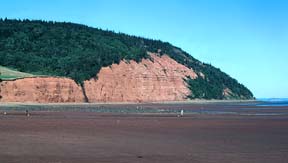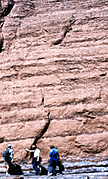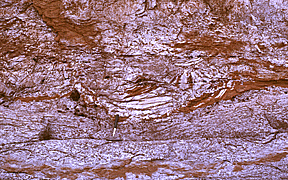

Cliffs of Blomidon Formation looking north at Cape Blomidon at low tide. The Blomidon Formation consists of cyclical lacustrine and eolian strata with significant amounts of nodular evaporites (mostly gypsum).

Meter-scale sedimentary sequences in the Blomidon Formation are called sand patch cycles (Smoot and Olsen, 1988). These consist of red laminated to massive mudstone overlain by brown to red sandy massive mudstone (sand-patch mudstones) with gypsum nodules. This may be overlain by vaguely ripple cross-laminated sandstone.
These cycles make up several orders of higher order cycles and appear to be related to precession and obliquity-related orbital forcing.
Quite often, in addition to sand patch fabric, these cycles contain larger features produced by evaporite dissolution (Ackermann et al., 1995). Below is an example of several bowl collapsed structures that were clearly infilled as evaporites dissolved.

REFERENCES
Ackermann, R. V., Schlische, R. W., and Olsen, P. E., 1995, Synsedimentary collapse of portions of the lower Blomidon Formation (Late Triassic), Fundy rift basin, Nova Scotia. Canadian Journal of Earth Science, v. 32, p. 1965-1976.
Smoot, J. and Olsen, P. E., 1988, Massive mudstones in basin analysis and paleoclimatic interpretation of the Newark Supergroup. W. Manspeizer (ed.), Triassic-Jurassic Rifting and the opening of the Atlantic Ocean, Elsevier, Amsterdam, p. 249-274.